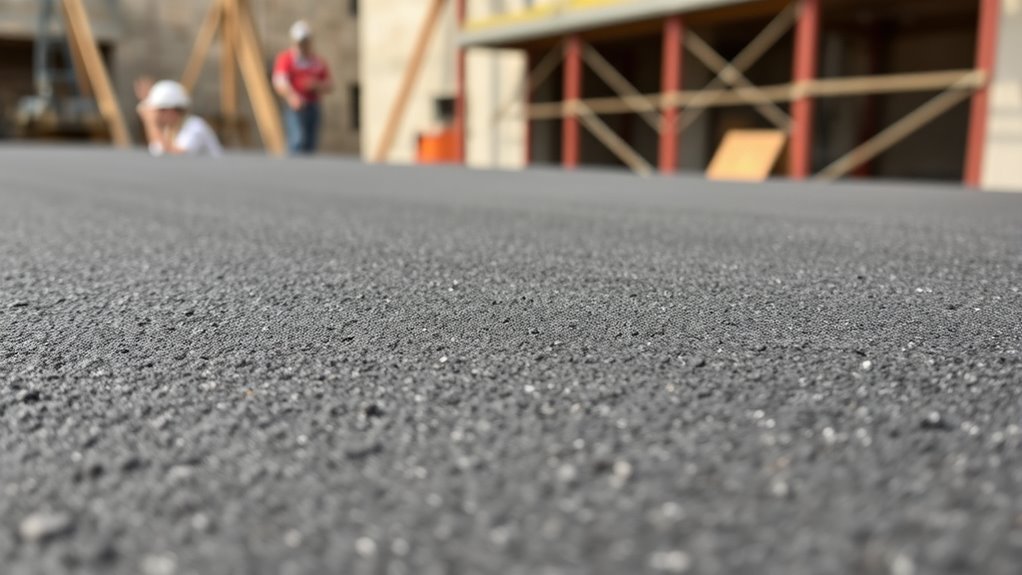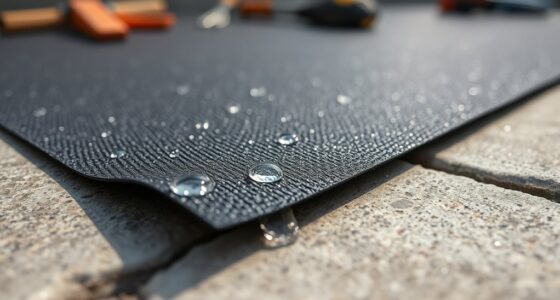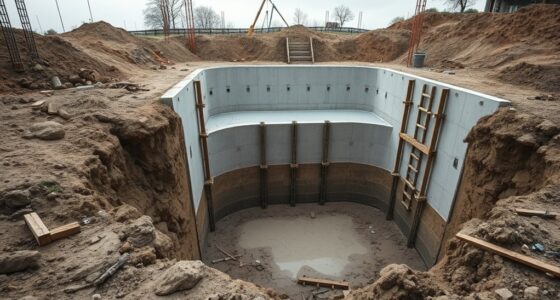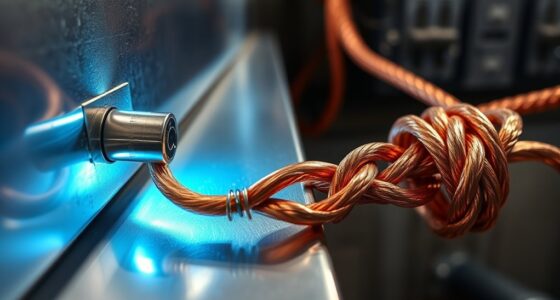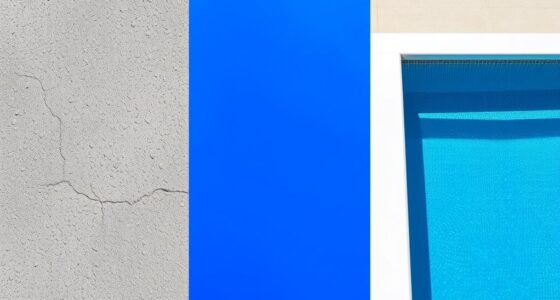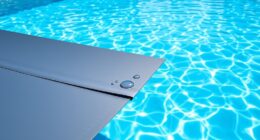Gunite is a popular choice among builders because it’s versatile, durable, and quick to apply for projects like pools, walls, and tunnels. Its high-pressure spray guarantees a strong, waterproof layer that bonds well to existing structures. However, it’s not ideal for unstable soils, projects requiring intricate designs, or when budgets and time are tight. To understand when gunite works best—and when other options might suit—you’ll want to explore further.
Key Takeaways
- Builders love gunite for its versatility, strong adhesion, and ability to conform to complex shapes quickly and efficiently.
- It offers durability and water resistance, making it ideal for pools, retaining walls, and underground structures.
- Gunite’s application requires skilled labor and equipment, which can increase costs and project timelines.
- Not suitable for unstable soil or sites with ground movement, as it can crack and lose structural integrity.
- Alternatives like vinyl liner or fiberglass pools may be better for quick, cost-effective projects with less need for customization.
What Is Gunite and How Is It Made?
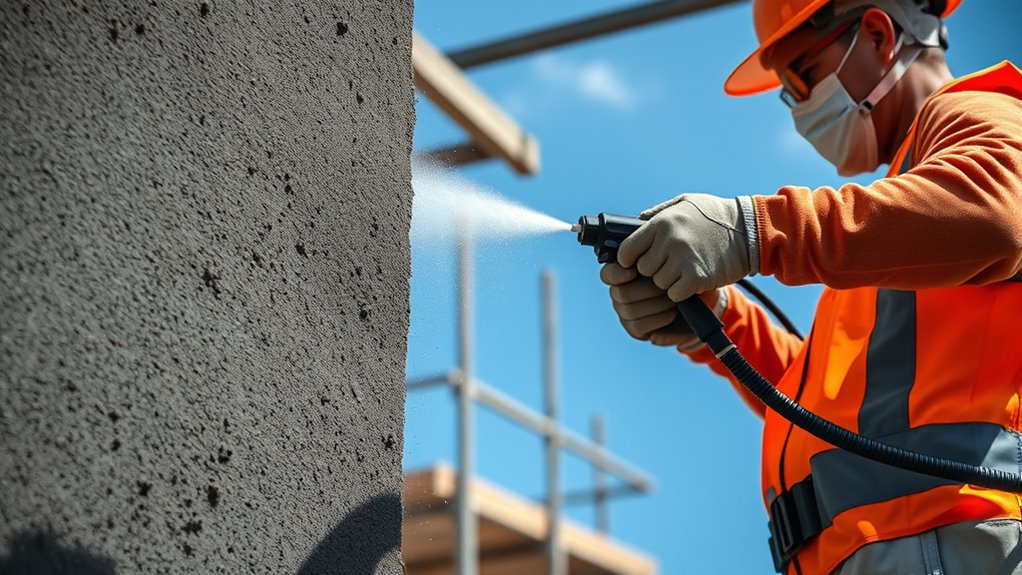
Have you ever wondered how gunite is produced? It starts with mixing dry ingredients—cement, sand, and aggregate—together. This dry mix is then pumped through a hose and combined with water at the nozzle. As you spray the mixture onto a prepared surface, it instantly hardens into a dense, durable layer. The process requires skill to guarantee the right consistency and proper application. Gunite is a form of shotcrete, which means it’s applied pneumatically through a high-pressure hose. This method allows it to adhere tightly to complex shapes and surfaces, making it ideal for pools, tunnels, and other structures. The key is the controlled spray that creates a strong, seamless finish, essential for many construction projects. Additionally, the high-pressure application ensures uniform coverage and adhesion, which is critical for the integrity of the finished structure.
The Benefits That Make Builders Favor Gunite
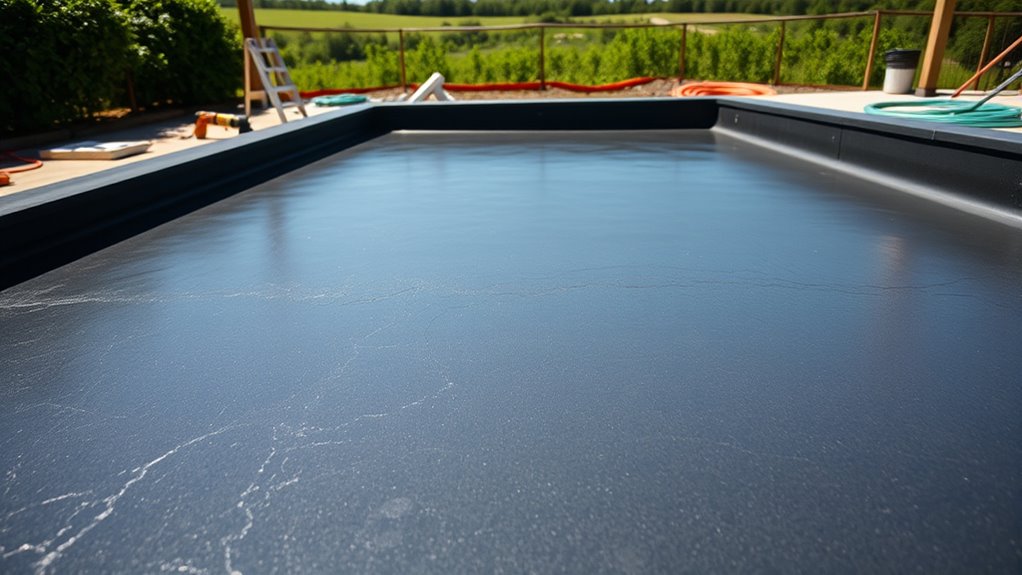
One of the main reasons builders prefer gunite is its exceptional versatility and strength. It adapts easily to various shapes and sizes, allowing you to customize pools, spas, or structural elements with intricate designs. Its durability stands out, as gunite can withstand changing weather conditions and heavy use without cracking or deteriorating. Additionally, it bonds strongly to existing structures, ensuring long-lasting stability. The material also offers excellent resistance to water penetration, reducing maintenance and preventing leaks over time. Gunite’s quick application process means you can complete projects faster without sacrificing quality. Furthermore, selecting the right portable camping gear can enhance outdoor projects by providing reliable tools and accessories for on-site work. Overall, its flexibility, resilience, and reliable performance make it a top choice for builders aiming for high-quality, long-lasting results.
Common Construction Projects Using Gunite
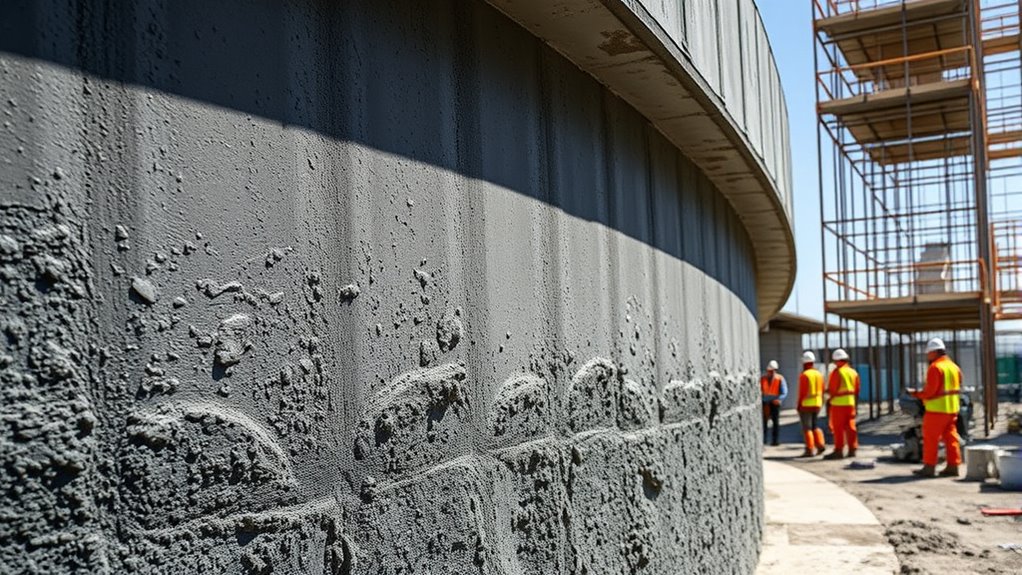
Gunite is a popular choice for a variety of construction projects due to its versatility and durability. You’ll often see it used in swimming pools because it creates a strong, seamless shell that resists cracking. It’s also ideal for retaining walls, where its ability to conform to complex shapes adds aesthetic appeal and stability. Gunite works well for custom fountains, sculptures, and decorative features, thanks to its moldability and finish options. Additionally, it’s frequently employed in underground infrastructure like tunnels and culverts, providing long-lasting reinforcement. Residential applications include driveways, patios, and fire pits, where its durability withstands weather and wear. Overall, gunite’s adaptability makes it a top choice for projects requiring robust, custom, and lasting solutions. Its moldability and finish options allow for a wide range of decorative possibilities, making it a preferred material in both functional and aesthetic applications.
Limitations and Challenges of Using Gunite
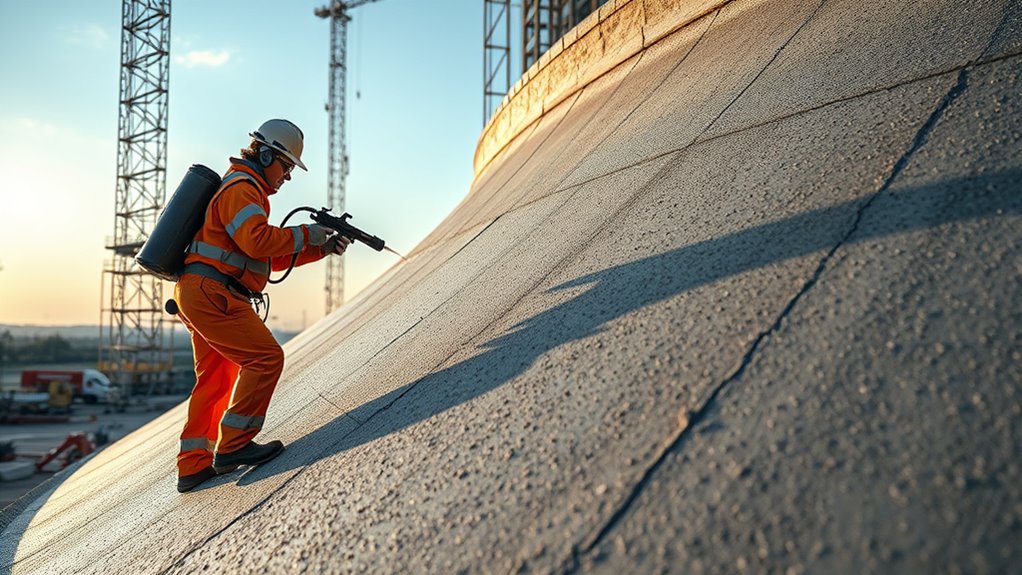
While gunite offers many advantages, it’s important to contemplate its limitations. You might find that the process can be costly and labor-intensive, affecting project budgets and timelines. Additionally, gunite has structural and design constraints that could impact your project’s flexibility. Moreover, understanding sound healing science can highlight alternative methods for relaxation and wellness that might better suit certain projects.
Cost and Labor Intensity
Using gunite can be costly and labor-intensive, posing significant challenges for your project budgets and timelines. The specialized equipment and skilled labor required increase expenses, making it less ideal for tight budgets. Installation demands careful planning, with crews needing to work efficiently to prevent delays. Here’s a quick comparison:
| Aspect | Impact |
|---|---|
| Equipment Costs | High, due to specialized spraying machinery |
| Labor Requirements | Skilled technicians needed, increasing labor costs |
| Application Time | Longer process, affecting project schedules |
This combination of high costs and labor demands means gunite isn’t always the best choice for every project, especially when speed and budget are priorities. Additionally, understanding the safety implications of gunite installation is essential to ensure a successful project.
Structural and Design Limits
Despite its versatility, gunite has notable limitations when it comes to structural and design applications. You might find it challenging to create intricate shapes or complex geometries, as gunite is best suited for smooth, curved surfaces rather than sharp angles or fine detail. Its thickness needs careful control; too thin, and it risks cracking or structural weakness. Additionally, large spans or heavy loads can be problematic, requiring reinforcement or alternative methods. Gunite also relies heavily on skilled application; uneven spraying can compromise strength and appearance. While it offers flexibility for many designs, you should recognize its constraints in highly detailed or load-bearing structures. Understanding these limits ensures you use gunite effectively and avoid potential issues down the line. Furthermore, self waterings plant pots demonstrate how careful design considerations can mitigate some limitations by reducing maintenance and improving longevity.
Signs That Gunite May Not Be the Best Fit
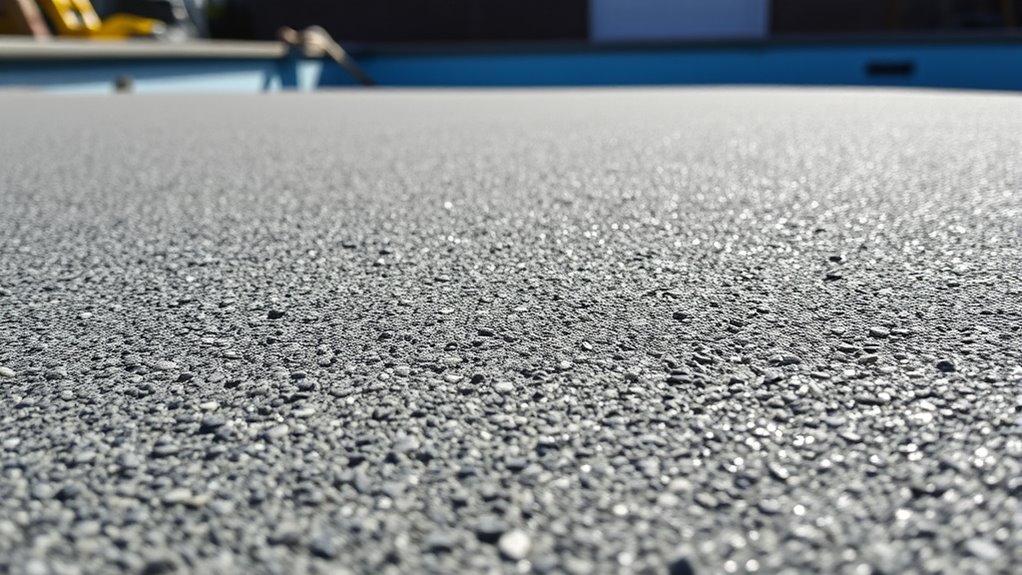
Gunite might not be the best choice if your project involves frequent ground movement or if you need a highly flexible structure. It’s rigid once cured, making it unsuitable for sites with unstable soil or shifting foundations. Signs that gunite may not fit your needs include:
Gunite’s rigidity makes it unsuitable for projects with unstable soil or frequent ground movement.
- Cracks appearing soon after installation
- Structural movement or shifting over time
- Projects requiring extensive flexibility or expansion
- Locations with persistent ground settling
- Need for rapid modifications or future adjustments
If you notice these issues or anticipate ongoing ground instability, consider alternative materials. Gunite’s strength is great for many applications, but its rigidity can lead to problems in dynamic environments. Recognizing these signs helps you avoid costly repairs or replacements later.
Alternatives to Gunite for Specific Applications
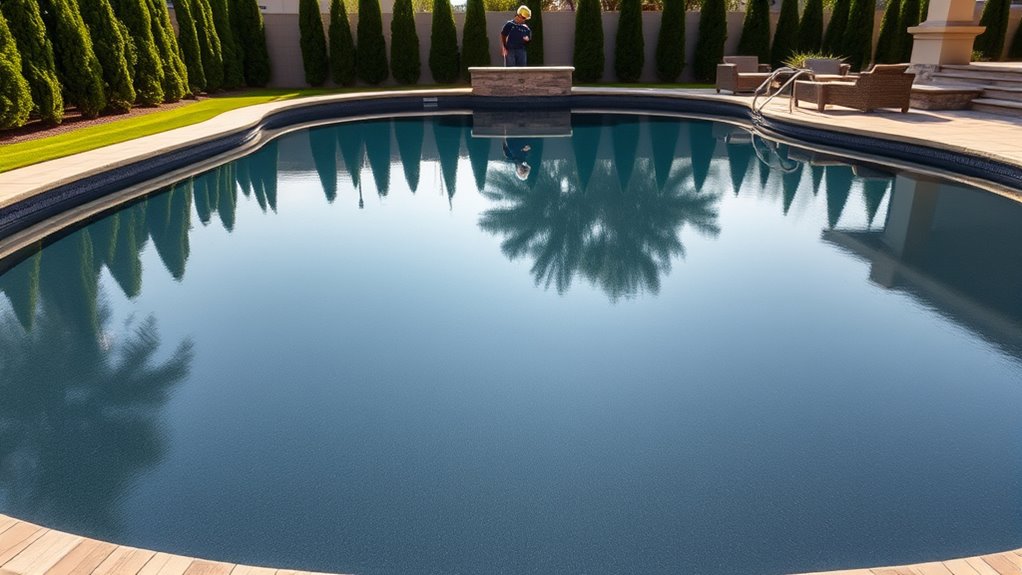
When gunite might not be the best choice, several alternatives can suit specific needs. Shotcrete offers quick construction for fast builds, while vinyl liner options provide affordability and flexibility. Fiberglass pools also present a durable, low-maintenance alternative for those seeking an easier setup. Additionally, understanding fraud detection techniques is essential for merchants to protect transactions and reduce chargebacks.
Shotcrete for Rapid Builds
Are you looking for faster alternatives to traditional gunite for specific construction projects? Shotcrete offers a quick, efficient solution, especially when speed matters. It’s applied using a high-pressure hose, allowing for rapid placement and minimal formwork. This makes it ideal for projects like tunnels, retaining walls, and swimming pools. Shotcrete can be sprayed directly onto surfaces, reducing labor time and accelerating construction schedules. Plus, its versatility lets you work with complex shapes and tight spaces more easily. When choosing shotcrete, consider these advantages:
- Faster application process
- Reduced labor costs
- Suitable for complex geometries
- Minimal formwork needed
- Excellent for underground or tight spaces
Shotcrete’s rapid application can markedly cut project timelines without sacrificing quality. Understanding the chemistry behind its adhesion and curing processes helps optimize its performance in various applications.
Vinyl Liner Alternatives
Looking for cost-effective and flexible alternatives to gunite for your swimming pool or water feature? Vinyl liner pools offer a popular option. They’re generally quicker to install and usually less expensive upfront. You can customize the shape and size more easily, making them ideal for unique or irregular spaces. The vinyl liner creates a smooth, waterproof surface, and replacing it is straightforward if it gets damaged or worn out. However, vinyl liners typically have a shorter lifespan—around 7 to 15 years—and may require more maintenance over time. They’re also less durable against sharp objects or heavy impacts compared to gunite. If budget and quick installation are your priorities, vinyl liner pools can be a practical choice, but consider long-term costs and durability for your specific needs. Selecting the right pool type is essential to ensure it aligns with your long-term maintenance expectations and usage.
Fiberglass Pool Options
Considering specific application needs, fiberglass pools present a durable and low-maintenance alternative to gunite. They arrive pre-molded, making installation faster and less labor-intensive. Fiberglass pools resist algae and require fewer chemicals, saving you time and money. They’re ideal for smaller yards or quick projects where a seamless, smooth surface matters. However, size options are limited compared to gunite, and customization is limited to the molds available. For specific situations, fiberglass pools excel:
- Quick installation timelines
- Low ongoing maintenance
- Resistance to algae growth
- Smooth, slip-resistant surfaces
- Suitable for small or irregularly shaped yards
Tips for Ensuring Successful Gunite Installations

To guarantee a successful gunite installation, proper planning and preparation are essential. Start by working with experienced contractors who understand gunite’s specific requirements. Ensure the site is well-prepared, with a solid, stable base and clear access for equipment. Communicate your expectations clearly and confirm the installation schedule. During application, monitor the spraying process to ensure proper water-cement ratio and consistent coverage. Avoid rushing the curing process—allow sufficient time for the gunite to set and cure properly. Protect the surface from rain, wind, or extreme temperatures during curing. Regularly inspect the work for cracks or uneven areas, addressing issues promptly. Additionally, staying informed about market trends and successful strategies can help you make better decisions throughout the project, ensuring your gunite structure is durable, smooth, and built to last.
Frequently Asked Questions
How Long Does It Take for Gunite to Fully Cure?
You’ll typically see gunite fully curing within 28 to 30 days. During this period, it’s vital to keep the surface moist and protected from extreme weather to prevent cracking. While the concrete may be strong enough for light use after about a week, avoid heavy loads or vigorous activities until the full cure is complete. Patience guarantees your gunite structure achieves maximum durability and longevity.
Is Gunite Suitable for Residential Swimming Pools?
Yes, gunite is suitable for residential swimming pools because it’s durable, versatile, and long-lasting. You benefit from its ability to conform to custom shapes and withstand harsh weather conditions. However, keep in mind it requires professional installation and proper curing time. If you want a pool that’s sturdy and customizable, gunite is an excellent choice. Just guarantee you hire experienced contractors to get the best results and minimize potential issues.
Can Gunite Be Applied in Cold Weather Conditions?
Yes, you can apply gunite in cold weather, but it’s not ideal. Cold temperatures slow down the curing process and can cause cracking or weak spots if not managed properly. To guarantee a quality application, you should use heaters, covers, or insulation to keep the temperature stable during application and curing. It’s best to consult with a professional experienced in cold-weather gunite to avoid potential issues.
What Maintenance Is Required for Gunite Structures?
You should regularly inspect your gunite structure for cracks, chips, or surface wear, and clean it to prevent buildup of dirt or algae. Sealing the surface every few years helps guard against water penetration and weather damage. While some might worry about maintenance costs, proper upkeep extends the lifespan of your gunite, saving you money in the long run. Staying proactive ensures your structure remains strong and visually appealing.
How Does Gunite Compare to Shotcrete in Terms of Strength?
Gunite and shotcrete are fundamentally the same in strength when properly applied, both offering high compressive strength suitable for various structural needs. However, gunite typically involves dry-mix application with water added on-site, allowing for more control and potentially denser, stronger finishes. Shotcrete often uses a wet mix, which can be faster but might result in slightly lower density. Overall, both provide excellent strength if correctly installed by skilled professionals.
Conclusion
Choosing gunite is like wielding a versatile brush—you can craft durable, custom shapes with ease. But remember, it’s not always the perfect fit. Knowing when to call in alternative options guarantees your project stays on solid ground. With proper installation tips, you’ll turn your vision into reality, as smoothly as a well-oiled machine. Trust your judgment, and you’ll build something that stands the test of time, just like a masterpiece in the making.
